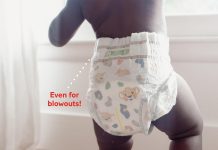At first glance, replacing worn-out changing pads may seem trivial, but for parents or caretakers of infants, it is a question worth pondering. With all the diaper changes and messes that come with caring for a little one, it’s essential to ensure that the changing pad remains clean and functional. This article will explore the importance of replacing worn-out changing pads and provide practical tips on when and how to do so. So, if you’re a parent or caregiver who wants to prioritize your baby’s comfort and hygiene, keep reading to learn more.
Review contents
Why Do Changing Pads Need to be Replaced?
Changing pads are essential for new parents, providing a comfortable and hygienic surface for diaper changes. However, these pads can become worn out over time and need replacement. A few key factors contribute to the need for replacement, including normal wear and tear, hygiene concerns, and safety issues.
Normal Wear and Tear
Like any other regularly used item, changing pads can experience normal wear and tear. The constant pressure and movement during diaper changes can cause the pad to lose shape and padding, making it less comfortable for the baby. Additionally, the seams and stitching on the pad can weaken over time, making it less durable and prone to tearing.
Hygiene Concerns
Maintaining proper hygiene during diaper changes is crucial for the health and well-being of both the parent and the baby. Changing pads can become a breeding ground for bacteria, as they are regularly exposed to urine, feces, and other bodily fluids. Even with regular cleaning, it can be difficult to remove all contamination traces, leading to a potential health risk. Replacing the changing pad ensures a clean and sanitary surface for each diaper change.
Safety Issues
Safety is paramount when caring for a baby; changing pads are no exception. Over time, the padding in the changing pad can become compressed and lose its support, potentially leading to an uncomfortable and unstable surface for the baby. This can increase the risk of the baby rolling or falling off the pad, which can result in injuries. Replacing the changing pad ensures the baby has a safe and secure area for diaper changes.
Factors Affecting the Lifespan of Changing Pads
The lifespan of a changing pad can vary depending on various factors. Understanding these factors can help parents decide when to replace their changing pads.
Quality of the Changing Pad
The quality of the changing pad itself plays a significant role in its lifespan. Higher-quality changing pads, often made with durable materials and reinforced stitching, tend to have a longer lifespan than lower-quality ones. Investing in a high-quality changing pad can save money in the long run, as it may not require frequent replacements.
Frequency of Use
How often a changing pad is used can also impact its lifespan. Parents who change their baby’s diapers more frequently may find that their changing pads wear out faster. On the other hand, if a changing pad is only used occasionally or as a backup, it may last longer before needing replacement.
Cleaning and Maintenance
Proper cleaning and maintenance can contribute to the longevity of a changing pad. Regularly wiping down the pad after each use and following the manufacturer’s cleaning instructions can help prevent bacteria buildup and keep the pad in good condition. Neglecting to clean and maintain the changing pad can accelerate wear and tear, shortening its lifespan.
Environment
The environment in which the changing pad is used can impact its lifespan as well. For example, if the changing pad is frequently exposed to excessive moisture, such as spills or leaks, it may deteriorate more quickly. Similarly, if the changing pad is stored in a damp or humid area, it may be prone to mold or mildew growth, leading to a need for replacement.
Signs that Indicate the Need for Replacement
Recognizing the signs indicating the need to replace a changing pad is essential for maintaining a safe and hygienic diaper-changing environment. Here are some common signs that it may be time to replace a changing pad:
Visible Wear and Tear
If there are visible signs of wear and tear on the changing pad, such as frayed seams, faded fabric, or flattened padding, it indicates that the pad is no longer in optimal condition. These signs not only affect the appearance of the pad but may also compromise its comfort and safety.
Torn or Damaged Surface
If the changing pad has any tears or damage to its surface, it should be replaced immediately. A torn changing pad can pose a potential safety hazard, as the baby’s skin can get caught in the damaged areas. Additionally, a damaged surface may be difficult to clean properly, leading to hygiene concerns.
Foul Odor
Changing pads can develop a lingering odor over time, even with regular cleaning. If, the changing pad continues to emit a foul odor despite proper cleaning, it may indicate a buildup of bacteria that cannot be eradicated. In such cases, replacing the changing pad is necessary to maintain a hygienic diaper-changing environment.
Stains that Cannot be Removed
Stains are inevitable with changing pads, as they are constantly exposed to bodily fluids. While some stains may be removable with proper cleaning, persistent or deep-set stains that cannot be removed may indicate an accumulation of bacteria or other contaminants. It is essential to replace the changing pad to ensure a clean and sanitary surface for the baby.
Loss of Padding or Support
Over time, the padding in a changing pad can become compressed and lose its original shape, resulting in a loss of support. This can make the changing pad uncomfortable for the baby and increase the risk of the baby rolling or falling off the pad. If the changing pad no longer provides adequate cushioning and support, it should be replaced to prioritize the baby’s safety and comfort.
Recommended Replacement Frequencies
The recommended replacement frequencies for changing pads vary depending on the pad type. Here are some guidelines to consider:
Disposable Changing Pads
Disposable changing pads are typically made of absorbent materials and are designed for one-time use. As such, they should be replaced after each use. This ensures the baby always has a clean and hygienic surface for diaper changes.
Fabric Changing Pads
Fabric changing pads, often made of soft and durable materials, can be used multiple times before needing replacement. However, replacing fabric changing pads every six months to a year is recommended, depending on their condition. Regular inspection for wear and tear signs and proper cleaning between uses can help extend their lifespan.
Vinyl or Waterproof Changing Pads
Vinyl or waterproof changing pads are designed to be more durable and easy to clean. They can withstand frequent use and are less likely to develop odors or stains than fabric pads. It is generally recommended to replace vinyl or waterproof changing pads every two to three years or as needed if there are visible signs of wear and tear.
Enhancing the Lifespan of Changing Pads
While eventually, all changing pads will need to be replaced, there are several steps parents can take to enhance their lifespan and ensure their safety and hygiene. Consider these measures to prolong the lifespan of a changing pad:
Using Liners or Covers
Using liners or covers on the changing pad can provide an extra layer of protection, reducing direct contact between the baby and the pad’s surface. Liners and covers are easily washable and help minimize stains and wear on the changing pad.
Regular Cleaning and Sanitizing
Proper cleaning and sanitizing after each use are essential for maintaining a hygienic changing pad. Follow the manufacturer’s instructions on how to clean the pad effectively. Regularly disinfecting the pad can help prevent bacteria buildup and extend its lifespan.
Proper Storage
Storing the changing pad properly when not in use can help prevent unnecessary damage and extend its lifespan. Ideally, the changing pad should be stored in a clean and dry area, away from excessive moisture or direct sunlight. This helps preserve the pad’s integrity and prevents mold or mildew growth.
Avoiding Excessive Moisture
Excessive moisture can deteriorate a changing pad more quickly, so it is essential to minimize exposure to liquids. Promptly clean up spills or accidents during diaper changes to prevent moisture from seeping into the pad. Additionally, regularly check for leaks or cracks in diaper cream or lotion containers that may come into contact with the pad.
Safety Considerations
Ensuring the safety of the baby during diaper changes is of utmost importance. Here are some safety considerations to keep in mind when using a changing pad:
Avoiding Changing Pad Overuse
While changing pads can provide a comfortable and secure surface for diaper changes, it is essential not to overuse them. Prolonged periods on a changing pad can put pressure on the back and neck of the baby, leading to discomfort. To minimize potential discomfort, limit the time the baby spends on the changing pad during diaper changes.
Checking for Hazards
Regularly inspect the changing pad for potential hazards, such as loose threads or damaged fasteners. These can pose a choking risk to the baby and should be addressed immediately. It is also essential to ensure the changing pad is placed on a stable surface and does not wobble or tip during use.
Avoiding Suffocation Risks
Never leave the baby unattended on a changing pad to prevent suffocation risks, even briefly. Babies can be surprisingly quick and may roll or move off the pad unexpectedly. Always keep a hand on the baby or use a safety strap if provided with the changing pad.
Monitoring Temperature
To ensure the baby’s comfort, it is essential to monitor the temperature of the changing pad and the surrounding environment. If the changing pad becomes too hot or cold, it may cause discomfort to the baby. Adjust the room temperature or use a barrier, such as a thin blanket or towel, between the pad and the baby if necessary.
When to Consult the Manufacturer
In some instances, it may be necessary to consult the manufacturer of the changing pad for specific replacement guidelines or to address any concerns regarding defective or poor-quality padding. If the changing pad shows signs of premature wear or tear or any safety concerns, reaching out to the manufacturer can provide valuable guidance and assistance.
Specific Replacement Guidelines
Some manufacturers may provide specific recommendations for when to replace their changing pads. These guidelines may consider the materials’ quality, expected wear and tear, and optimal lifespan. Following the manufacturer’s guidelines can ensure that the changing pad is replaced at the appropriate time.
Defective or poor-quality padding
If the changing pad exhibits defective or poor-quality padding, such as uneven cushioning or loss of support, it is crucial to contact the manufacturer. Defective padding can pose a safety risk for the baby and should be addressed promptly to prevent potential injuries.
Alternatives to Traditional Changing Pads
While traditional charging pads are widely used and effective, there are alternative options available for parents who may prefer different alternatives:
Washable Changing Pad Liners
Washable changing pad liners are an environmentally friendly alternative to traditional changing pads. These liners are placed on the pad and easily removed and washed after each use, protecting the underlying pad from stains and wear.
Portable Changing Mats
Portable changing mats are compact and lightweight, making them convenient for parents on the go. These mats often fold up or roll into a small size for easy transportation. While they may not provide the same cushioning and support as traditional changing pads, they offer a temporary and convenient solution for diaper changes outside the home.
Disposable Changing Pad Covers
Disposable changing pad covers are similar to disposable changing pads but are designed to be placed directly on top of a reusable changing pad. These covers provide a disposable barrier between the baby and the pad, minimizing the need for frequent cleaning and extending the lifespan of the underlying pad.
Final Thoughts
Changing pads is vital in providing a comfortable and hygienic surface for diaper changes. Understanding when and why changing pads need to be replaced is essential for the safety and well-being of the baby and the parent.
By recognizing the signs of wear and tear, practicing proper cleaning and maintenance, and following the recommended replacement frequencies, parents can ensure that their changing pads remain in optimal condition and continue to provide a safe and clean environment for their little ones.
Remember, the baby’s well-being always comes first, so if in doubt, don’t hesitate to consult the manufacturer or replace the changing pad to prioritize the baby’s comfort and safety.






























